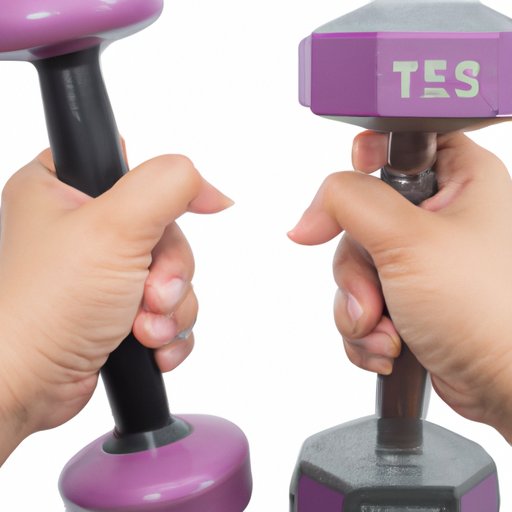
Introduction
Staying active during pregnancy is important for both the mother and the baby. Exercise can help alleviate common pregnancy symptoms such as fatigue and back pain, reduce the risk of gestational diabetes and preeclampsia, and improve overall mental health. However, many pregnant individuals may question whether lifting weights is safe during this time. This article will explore the dos, don’ts, and benefits of strength training during pregnancy.
The Do’s and Don’ts of Lifting Weights During Pregnancy
Pregnant individuals should take safety measures and precautions while weightlifting to avoid any harm that may come to themselves or their baby. It is important to consult with a medical professional before starting any exercise routine and to always listen to your body. Avoid exercises that cause discomfort, dizziness, or pain.
While lifting weights, avoid holding your breath and use equipment with caution. When standing, maintain a straight posture with your shoulders back and avoid arching your back. Lastly, do not overexert yourself, as this may increase the risk of injury.
Benefits of Strength Training During Pregnancy
Strength training can bring many benefits to pregnant women. Performing resistance exercises can help build endurance, increase strength, and help stabilize the body. These benefits can support essential daily tasks such as carrying the baby, lifting groceries, or climbing stairs.
Research has shown that strength training can also help reduce the risk of gestational diabetes and preeclampsia, and may also lead to shorter labor times and faster postpartum recovery.
Further, it can positively affect the baby’s development and contribute to a healthy pregnancy both during and post-delivery. Babies born to active mothers may have better cardiovascular function, lower body fat percentage, and a reduced risk of developing chronic diseases in the future.
Top 5 Exercises to Safely Lift Weights During Pregnancy
1. Goblet Squats: This exercise helps strengthen the legs, glutes, and core. Hold a weight close to your chest and stand with your feet shoulder-width apart. Slowly lower into a squat position, keeping your chest and head up.
2. Bicep Curl: Hold light dumbbells and stand with your feet shoulder-width apart. Keep your elbows close to your sides and lift the weights towards your shoulders.
3. Shoulder Press: Hold light dumbbells and stand with your feet shoulder-width apart. Lift the weights slowly above your head, keeping your back straight.
4. Chest Press: Laying on your back with your knees bent, start with low weights and gradually increase as your pregnancy progresses. Take caution to avoid putting excess pressure on your belly.
5. Reverse Fly: Hold light dumbbells and keep your back straight. Lift the weights up towards your shoulders, squeezing your shoulder blades together as you lift.
When performing any of these exercises, make sure to use proper form, breathe calmly, and avoid heavy weights. Additionally, it is important to modify these exercises as your pregnancy progresses and consult with a medical professional if you are uncertain whether the exercise is suitable for you.
When to Stop Lifting Weights During Pregnancy
While it is safe to perform resistance training during pregnancy, there are signs that indicate when it is time to stop. If you experience any pain, shortness of breath, dizziness, or signs of preterm labor, stop exercising and contact your medical professional. Additionally, if you have a high-risk pregnancy it is important to inform your medical professional of your exercise routine to adjust or modify exercises as needed.
If you need to discontinue lifting weights due to any complications or risks, look for less strenuous exercises such as walking, swimming, or yoga. These activities can also help support a healthy pregnancy and reduce stress and anxiety levels.
Myths and Facts About Lifting Weights During Pregnancy
There are many myths surrounding weightlifting during pregnancy, such as that it can cause a miscarriage; but research has proven that this is untrue. As mentioned earlier, instead of harming the baby, lifting weights helps with their development. Additionally, lifting weights does not cause early delivery, but it is important to avoid over-exerting oneself, which may stress the body and increase the chance of complications such as early delivery.
Preparing Your Body for Postpartum Fitness Through Weight Lifting During Pregnancy
Strength training during pregnancy can also prepare your body for postpartum recovery. Lifting weights can help maintain muscle mass and bone density, which often decrease during pregnancy. This can greatly benefit postpartum recovery, as well as reduce the risk of postpartum depression.
After giving birth, it is important to start slowly when returning to strength training. Start with low-intensity exercises, such as body weight movements and light weights. Also, listen to your body and take things day by day, gradually increasing the intensity as your body permits.

Listening to Your Body: Exercising Safely During Pregnancy
Listening to your body is important while strength training during pregnancy. While it is essential to maintain fitness, it is equally important to practice self-awareness. Make sure to drink enough water, avoid overheating, and get enough rest. Additionally, maintaining a healthy and balanced diet is important to support the added physical strain and ensure the baby’s and mothers’ adequate nutrition.
Conclusion
Lifting weights during pregnancy is safe as long as you follow the precautions and safety measures recommended above. Proper strength training can provide numerous benefits to both mother and baby, including improved health outcomes and easier postpartum recovery. Make sure to consult with a medical professional before beginning any exercise routine to ensure you are following the best individual plan for your needs.
Additional resources to help guide safely exercising during pregnancy are available on many websites, such as the American Pregnancy Association or the Mayo Clinic.




